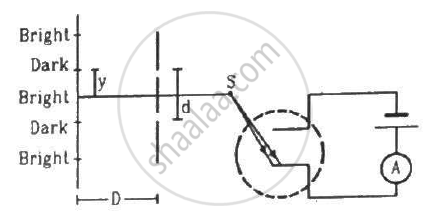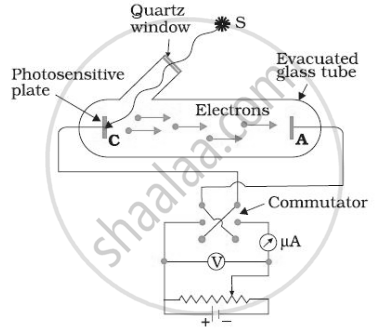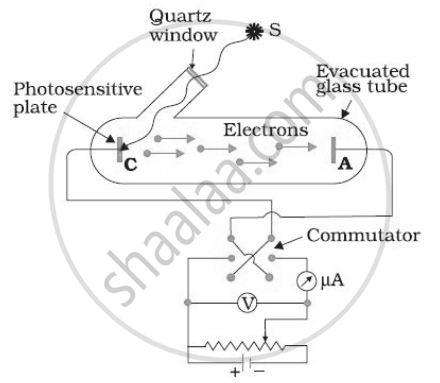Advertisements
Advertisements
Question
A silver ball of radius 4.8 cm is suspended by a thread in a vacuum chamber. Ultraviolet light of wavelength 200 nm is incident on the ball for some time during which light energy of 1.0 × 10−7 J falls on the surface. Assuming that on average, one photon out of every ten thousand is able to eject a photoelectron, find the electric potential at the surface of the ball, assuming zero potential at infinity. What is the potential at the centre of the ball?
(Use h = 6.63 × 10-34J-s = 4.14 × 10-15 eV-s, c = 3 × 108 m/s and me = 9.1 × 10-31kg)
Solution
Given:-
Radius of the silver ball, r = 4.8 cm
Wavelength of the ultra violet light, λ = 200 nm = 2 × 10−7 m
Total energy of light, E = 1.0 × 10−7 J
We are given that one photon out of every ten thousand is able to eject a photoelectron.
Energy of one photon,
`E^' = (hc)/lambda`,
where h = Planck's constant
c = speed of light
`lambda` = wavelength of light
On substituting the respective values in the above formula, we get :
`E^' = (6.63 xx 10^-34 xx 3 xx 10^8)/(2 xx 10^-7)`
`=9.945 xx 10^-19`
Number of photons,
`n = E/E^' = (1 xx 10^-7)/(9.945 xx 10^-19) = 1 xx 10^11`
Number of photoelectrons
= `(1 xx 10^11)/10^4 = 1 xx 10^7`
The amount of positive charge developed due to the outgoing electrons,
`q = 1 xx 10^7 xx 1.6 xx 10^-19`
`= 1.6 xx 10^-12 C`
Potential developed at the centre as well as on surface,
`V = (Kq)/r`,
where K = `1/(4piε_0)`
`therefore V = (9 xx 10^9 xx 1.6 xx 10^-12)/(4.8 xx 10^-2) = 0.3 V`
Potential inside the silver ball remains constant. Therefore, potential at the centre of the sphere is 0.3 V.
APPEARS IN
RELATED QUESTIONS
The threshold frequency for a certain metal is 3.3 × 1014 Hz. If light of frequency 8.2 × 1014 Hz is incident on the metal, predict the cutoff voltage for the photoelectric emission.
Is the formula you employ in (a) valid for calculating radius of the path of a 20 MeV electron beam? If not, in what way is it modified?
An electron gun with its collector at a potential of 100 V fires out electrons in a spherical bulb containing hydrogen gas at low pressure (∼10−2 mm of Hg). A magnetic field of 2.83 × 10−4 T curves the path of the electrons in a circular orbit of radius 12.0 cm. (The path can be viewed because the gas ions in the path focus the beam by attracting electrons, and emitting light by electron capture; this method is known as the ‘fine beam tube’ method. Determine e/m from the data.
What is so special about the combination e/m? Why do we not simply talk of e and m separately?
If light of wavelength 412.5 nm is incident on each of the metals given below, which ones will show photoelectric emission and why?
| Metal | Work Function (eV) |
| Na | 1.92 |
| K | 2.15 |
| Ca | 3.20 |
| Mo | 4.17 |
Two neutral particles are kept 1 m apart. Suppose by some mechanism some charge is transferred from one particle to the other and the electric potential energy lost is completely converted into a photon. Calculate the longest and the next smaller wavelength of the photon possible.
(Use h = 6.63 × 10-34J-s = 4.14 × 10-15 eV-s, c = 3 × 108 m/s and me = 9.1 × 10-31kg)
In the arrangement shown in the figure, y = 1.0 mm, d = 0.24 mm and D = 1.2 m. The work function of the material of the emitter is 2.2 eV. Find the stopping potential V needed to stop the photocurrent.

(Use h = 6.63 × 10-34J-s = 4.14 × 10-15 eV-s, c = 3 × 108 m/s and me = 9.1 × 10-31kg)
Work function of aluminium is 4.2 eV. If two photons each of energy 2.5 eV are incident on its surface, will the emission of electrons take place? Justify your answer.
The stopping potential in an experiment on photoelectric effect is 1.5V. What is the maximum kinetic energy of the photoelectrons emitted? Calculate in Joules.
In Photoelectric effect ______.
In the experimental set up for studying photoelectric effect, if keeping the frequency of the incident radiation and the accelerating potential fixed, the intensity of light is varied, then ______.

For a given frequency of light and a positive plate potential in the set up below, If the intensity of light is increased then ______.

In various experiments on photo electricity, the stopping potential for a given frequency of the incident radiation is ______.
When a beam of 10.6 eV photons of intensity 2.0 W/m2 falls on a platinum surface of area 1.0 × 10-4 m2, only 53% of the incident photons eject photoelectrons. The number of photoelectrons emitted per second is ______.
Cathode rays can be deflected by
In photoelectric effect, the photoelectric current
